The Irish Nationalist success of the early 20th century is not just a model for Southern Nationalists, but other Nationalist groups as well. Unfortunately, groups that would otherwise study the success of this particular revolutionary movement often allow religious, cultural, and/or historic biases to blind them from a case study in successful Nationalist strategies. In large part, I blame the relatively recent “Troubles” of Northern Ireland for creating unjustified blinders.
The fight over Irish unification beginning in the 1960s took on a markedly religious and economic-social justice dynamic. Catholic versus Protestant… English and Scots-Irish versus Irish… Marxist versus “Capitalist”… all of these labels formed the confusion of the Troubles. But the Irish War of Independence and the various factors that led up to that event have very little in common with the Northern Ireland experiences from 1969 (beginning at the “Battle of the Bogside”) and lasting at least until the Good Friday Peace Accord of 1998.
The Irish in the Republican South enjoyed significant Protestant support throughout the 19th and early 20th centuries. Many of the Irish leaders were Protestants – specifically, Presbyterians and Methodists. The Catholic Church firmly sided with the United Kingdom, going so far as to threaten excommunication of Irish Republican leaders. Anglo-Irish patriots were crucial to the formation of a successful Irish Nationalist movement in turn of the 20th century Ireland. Most importantly, however, is not the peculiarities of the Irish ethno-religious constructs, but the applicable lessons that can be gleaned from a successful Nationalist movement.
Learning from others as to how they succeeded should never be ignored and it is a simple fact that the Irish, after a minimum of sixteen previous attempts to secede from British rule, eventually did so. We need to know why. Just as an American military commander should learn from the Vietnam and Iraq Wars, British Nationalists can learn a lot from the Irish experience of the 1910s.
I am rooting for Anglo Nationalists to reclaim England from the detestable hordes who have hijacked that once brilliant Empire. My heart is with Southern Nationalism; my soul is with Irish Nationalism. But intellectually, I fully embrace the fact that a win for Nationalist movements globally is a win for us all. Defeating the Globalists and their Marxist foot soldiers – especially their Cultural Marxist pawns – is important for the long-term vitality of all of our diverse cultures and righteous virtue.
They worship money. We worship God. We honor our forefathers. They honor no one.
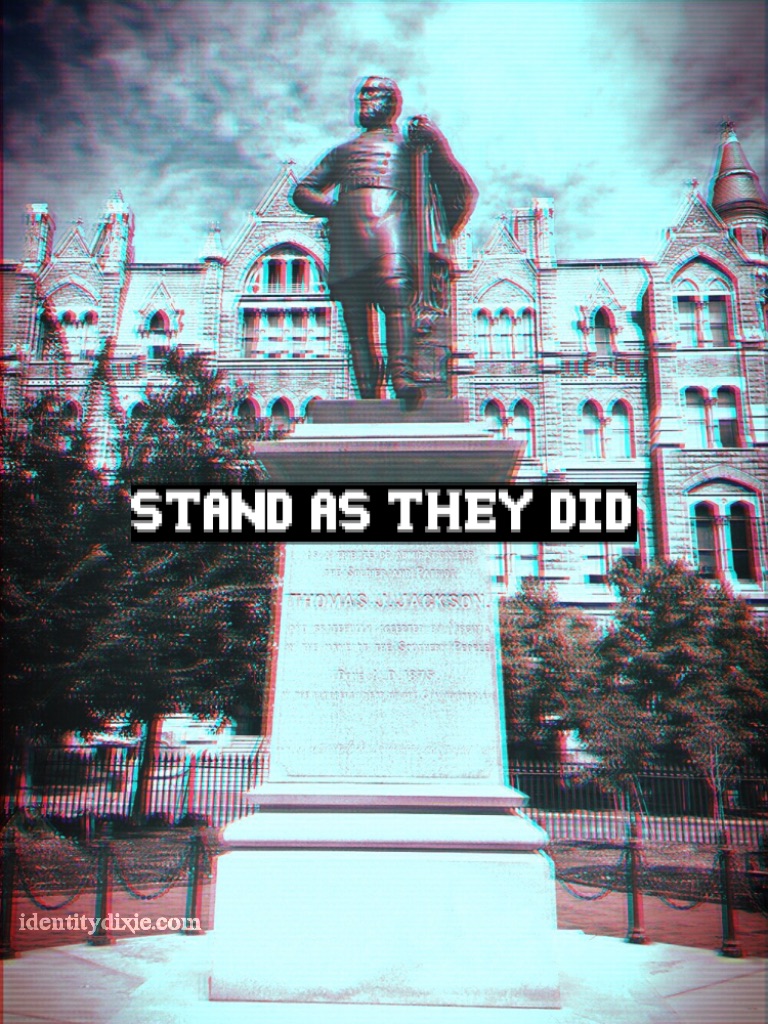
Now, as I enter this third and final segment on Nationalist Lessons from the Irish, I want to take you a step forward in time before I can bring you back. All Nationalist movements should study and implement, to some degree, the “OODA Loop.” For those unfamiliar with the concept designed by U.S. Air Force Colonel John Boyd, the OODA Loop is a concept predicated on the cyclical construct of decision making and acting in a fluid environment. It is defined by a series of actions and reactions: Observe-Orient-Decide-Act.
The OODA Loop deserves its own series of articles, but for the sake of this piece, it plays a critical, albeit accidental role in the success of the Irish War of Independence. The Irish leadership was not thinking of “OODA Loops” while formulating their strategic and tactical designs against their British occupiers. However, what comes out of the Irish command and control system is a near perfection of the implementation of the OODA Loop as it pertains to speed of decision making for both its military and political leadership. That speed contributed to a holistic asymmetry for which the British were unprepared.
Previous failures to attain freedom by the Irish played into British hands. The Irish had become predictable. The Easter Rising of 1916 is a good example of yet another failed attempt of the Irish to fight the British like… Brits. The strategic transformation that changed the operating principles of the Irish Volunteers (later called the Irish Republican Army) was born out of necessity and clarity. Senior leaders, notably men like Michael Collins and Tom Barry, recognized that this was a losing strategy. Learning from the Boer Wars of a couple decades earlier, the Irish flying column was designed out of necessity. But “why” it succeeded, whereas the Boer Kommando units ultimately failed, is important to address.
In part, as I discussed in Part I of this series, it was a calculated multigenerational decision to invest the Irish population into a Nationalist bloc (not ‘block’). In part, as I discussed in Part II of this series, it was a tactical transformation that enjoyed the benefit of learning what worked and did not work from the experiences of their Boer colleagues. A constrained geographic space further helped (although, it could have hurt them).
However, I believe the large contributor to Irish flying column success was due to the preparatory work of the Irish in the cultivation of leadership.
The Irish leadership had been built carefully over time. They created a secret society (the Irish Republican Brotherhood) to form bonds, develop talent, elevate and protect fellow “Brothers,” and hone a singular Nationalist vision and message. Members of the IRB may not have always been fully on board with one another’s strategies, but they were always on board with the vision. These were deeply personal connections. Brothers met one another… ate with one another… drank with one another… fellowship was critical to building allegiances that would pay dividends in the years to come.
As long as Nationalist movement groups remain as impersonal, obscure, online assemblies, the necessary interpersonal connections required to win their causes will never be fulfilled.
Obviously, the Irish in the late 19th century did not meet in secret Facebook chat sites. They did use some postal services to communicate with one another. But the most important method of the IRB was face to face communications.
Interpersonal cultivation of leadership and camaraderie are critical to the most important component of the OODA cycle – “Orient(ation).” Fortunately, it is also the most important advantage of Nationalist movements globally. We are advocating for those like us.
Diversity is not a strength. In fact, when confronted by an ever-changing battlefront and a massive enemy, diversity is an extreme weakness. It creates confusion. It harms that which I will call “observation symmetry.” In Boyd’s OODA Loop concept, recognizing or observing changes in the tactical landscape is crucial to the downstream actions of the warrior(s). For Boyd, this translated to the fighter pilot closing rapidly upon an enemy fighter pilot. Observing changes in conditions, both for your own aircraft and the details of the aircraft that was fast approaching; perhaps, the many aircraft fast approaching. When it is only one pilot, observation symmetry is more quickly addressed and rectified. But what about the group facing another group?
Intuitively, the smaller the group, the easier it is to get on the same page with regard to an appreciation for the threat it is facing and the circumstances surrounding the engagement with which they are about to engage. We have all played some version of the game in which a picture may be interpreted in a few ways – often an old or young lady, based on perspective. While different eyes may be able to detect both the old lady and the young lady, unlike a picture, a real life fight requires you to decide quickly as to which is it – the old OR the young lady coming at you? Is the heavy weaponry a few hundred yards away the greater threat than the armor that is twenty kilometers down the road? How many of the mainstream reporters are actually working directly with the AntiFa? Who are they? Etc.
The speed at which these observations are made and processed is crucial to the speed of decision making. Speed of decision-making is, of course, only as good as the outcome. Therefore, making a fast decision for its own sake is not enough. The accuracy of information processed in the fastest way will enable the commander and his team to act in a way that gives him the greatest chance of success. It also disrupts the opposing side’s observation phase.
If before the opposition your smaller team has identified and deciphered critical data (Observe), then oriented that data into actionable options (Orient), followed by a decision as to the best course of action (Decide), and acted (Act), you create a tactical environment in which your movements are forcing the opposition to constantly recycle – i.e., get stuck in “Observe” mode. This gives your team an enormous tactical advantage. They are reacting to your actions and as such, constantly having to “re-observe” and “re-orient” the intelligence in real time.
Robert Coram’s, Boyd: The Fighter Pilot Who Changed the Art of War, discusses this advantage:
“The speed must come from a deep intuitive understanding of one’s relationship to the rapidly changing environment… Understanding the OODA Loop enables a commander to compress time – that is, the time between observing a situation and taking action. A commander can use this tempered discrepancy… to select the least-expected action rather than what is predicted to be the most-effective action… To take the least-expected action disorients the enemy. It causes him to pause, to wonder, to question. This means that as the commander compresses his own time, he causes time to be stretched out for his opponent. The enemy falls farther and farther behind in making relevant decisions. It hastens the unraveling process.” (Pg. 336)
The Irish flying columns were small. Michael Collins’ primary intelligence team, “The Squad,” was small. Meanwhile, the British were a behemoth unto themselves. They employed a diverse military apparatus against the Irish Republican Army. The Irish not only anticipated British actions faster, because they knew the British, but they could change almost on a dime and exploit any delay in imperial response. Size made the pauses longer and more predictable.
Additionally, the British relied on five separate groups to suppress the Irish. These included: (1) a contingent of loyal Irish – the Royal Irish Constabulary [RIC]; (2) Auxiliaries – a counterinsurgency unit comprised primarily of British officers, officially under the RIC, but largely independent; (3) Deputized Constables, also known as “the Black and Tans” – an independent group of primarily English and Scottish veterans, many with criminal records, who were also officially under the RIC; (4) the regular British Army; (5) MI5 – the domestic intelligence unit of the United Kingdom. In addition, the north was managed by the Ulster Special Constabulary, while Dublin had a Metropolitan Police Force that added to the confusion.
The Irish exploited the size of an unwieldly and often competing number of entities. As these units experienced losses and frustration grew, they began competing at levels of brutality. The Irish exploited that growth in violence for political and propaganda purposes. This became worse as British units often came into a town either multiple times or with separate, uncoordinated units. Those units were acting on the same intelligence. Not only did the units lack coordination, the size of the forces seemed unnecessarily gratuitous – adding to the mythology of the much smaller flying columns.
Finally, the diversity of units and mission perspectives made observation confusing for the sake of regrouping and launching new attacks. The RIC, Auxiliaries, Black and Tans, British Army, and MI5 each had a different perspective on threat assessments, operational conditions, strategic priorities, etc. Depending on the geography, the concentration of independent units contributed to a mass that not only made it harder for them to avoid Irish attacks, it also made it harder to respond.
To put this in perspective, imagine a game of “whack-a-mole” with five different hands wielding five different hammers in a tightly constrained space… only this time, the mole is more than a mole. Smaller, more concentrated Nationalist organizations with a clear mission should prefer to face multiple parties who appear to have a single goal, but in fact compete with one another over two key motivations that make actionable observation more challenging: glory and personal pride.
This lack of unit and operational cohesion was problematic on its own, but there is more to Boyd’s Orient(ation) phase of his OODA Loop – and it is critical to Nationalist success: Group Homogeneity.
Franklin Spinney was one of John Boyd’s best friends and colleagues. He developed a rudimentary diagram that charts the O-O-D-A concept on a horizontal path, from engagement to action or reaction. The Orient phase as envisioned by Boyd and drawn by Spinney explains why the Irish Nationalists would have enjoyed a distinct advantage over the British at the turn of the 20th Century. The Orientation phase of an OODA Loop was not only the key to Irish success in 1921, it is the key to future Nationalist success.
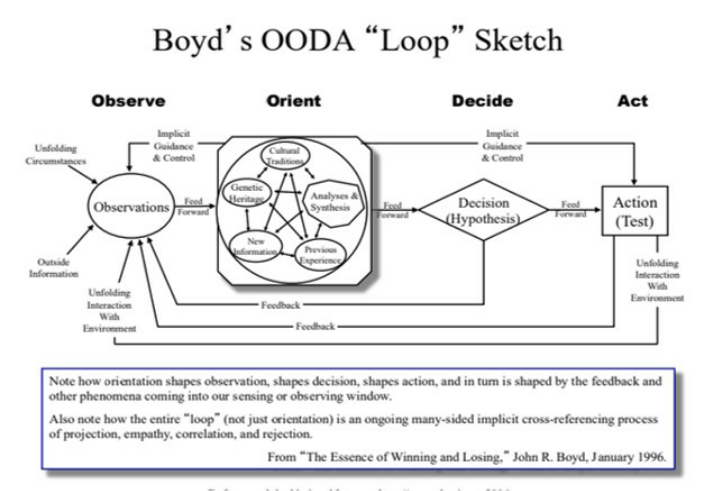
Boyd’s Orient phase includes “Cultural Traditions,” “Previous Experience,” and “Genetic Heritage,” as components of this crucial phase of the OODA Loop. While Boyd probably did not consider this a holistic list of Orientation influencers, it is clear where he is going. The personal construct of the commander – that which makes him up – will influence the list of options he will consider, given the observed circumstances he has inherited. His upbringing and DNA will influence his outlook of the situation and available options for response.
This offers a great advantage for the Nationalist. The more culturally, and I would argue genetically coherent the team, the more effective it will be when understanding the commander’s perspective of the situation, his view of the tactical options, and the rationale for the decisions being made. More importantly, it makes execution more likely. The team will come to similar conclusions, or at least understand the logic.
The Irish were a monolithic people, but they were forced to fight at such a local level that the flying column was comprised of a tightknit, genetically cohesive group (often of kin). The British, by contrast, were fighting with a multitude of parties, not only from throughout the United Kingdom, but throughout the various regions and towns of the countries that comprise the UK. The English commander from Hastings leading the English enlisted veterans from the Midlands would be challenging enough. Add to that complexity the introduction of Scottish or even Irish volunteers, and operational efficiency is greatly harmed. Now add the additional element of making decisions rapidly with such a disparate group.
Lieutenant Colonel Jeffery N. Rule, US Marine Corps, put this advantage most succinctly in his US Army War College Strategy Research Project:
It is in the orientation phase that one can create external unpredictability (through presenting ambiguous, deceptive, or novel situations) while at the same time reinforcing one’s own internal harmony (through commander’s intent, shared values, discipline, training, etc.). Tempo is more than just making decisions quickly; it is specifically relevant to the adversary’s orientation and observations — which also touches on the importance of empathy. The ability of an organization (or individual) to act (or not act) continuously at the right time, in the right place, such that his opponent is forced to react, will lead to ever increasing advantages to the point where the opponent experiences such disorder and confusion that his will to resist is broken.
The small flying columns – centrally directed by a Dublin command, but granted significant operational latitude at the local level – would have a clear advantage over the British units – centrally directed from London and limited operationally by bureaucratic, political, and cultural constraints.
As I stated earlier, diversity is not a strength, and nothing proved this more than the Irish War of Independence. I would also say the lack of diversity has been the key strength of other successful insurgency movements over time. Not only does a lack of diversity offer protection from infiltration, as demonstrated, it also greatly assists tactical decision making in a fluid environment.
Boyd argues that various personal factors go into the Orient Phase of the OODA Loop. This is the phase with which the small group and commanders process the Observation before deciding on an act. This is where options are laid out. This is where the tactics are considered. The faster those tactics are considered and determined, the faster the unit can move efficiently.
For Nationalist movements it is important to first recognize that you are in the very slim minority. Whether you are the Irish seeking independence in 1916, the German patriot seeking a political change during the degenerate Weimar Republic, or a British-American Colonist in the 18th Century, you will always find yourself at a numerical disadvantage. That is because disruption to the status quo is uncomfortable and the masses love comfort. Today, the Nationalist faces an enemy, Globalists, who thrive on exploiting comfort.
Globalists know that very few want to run the risk of being doxxed for a cause bigger than themselves. They prey upon those who would rather enjoy social acceptance to Godly affirmation. Globalists, at their core, are predatory in every way. They are oppressive in their quest for global dominance. But they suffer from three key weaknesses which speak directly to OODA Loops and share similarities to that which the Irish faced at the turn of the 20th Century.
First, Globalists embrace diversity for its own sake and as such, this creates sharp difficulties in consensus building. Even now, Cultural Marxists, the foot soldiers of the Globalist movement, are fighting amongst themselves over issues such as “trans rights” versus “feminism,” black empowerment movements that exclude or diminish “others,” and leadership councils in which gender, race, and/or disabilities compete for hegemony.
Just as the Irish exploited rifts within the coalition sent to suppress them, so too should we pounce on these differences.
Second, the competition for temporal gain within globalist groups is a major weakness. To be sure, many so-called Nationalist groups suffer from narcissistic, glory hounds. These wanna’ be “Hitlers” cannot wait to launch the next Beer Hall Putsch. Ignore such creatures. Genuine Nationalists – loyal patriots to their culture, heritage, and God – are willing to sacrifice for the greater good. Globalists do not understand sacrifice. They have never been truly challenged. Rather, they either chase financial or social gain – most often both. This transparency offers a great opportunity to target the rewards versus the individuals themselves.
As I covered in Part II of this case study, the Irish targeted technocratic, mid-level managers for elimination. The goal was to deprive willing bureaucrats from taking career-advancing positions in Ireland and maintaining British managerial proficiency. For the British bureaucrat, the benefits (pride, prestige, advancement) no longer outweighed the cost (potential death by the Squad). I am not advocating the killing of anyone. Rather, I am arguing that you take away the reward.
Suddenly being a transgender freak is no longer valuable in a society that understandably laughs at self-loathing men… being a globalist who exports production to the detriment of his people is not so cool when politicians begin to target such profits with tariffs… being a university that targets White students for exclusion is not so hip when endowments and ratings suffer… Eliminate the reward and you eliminate the motivations of the Globalist.
Our reward is the defense and success of our people. It is our freedom. They have to target all of us because our reward is all of us. That is the very essence of Nationalism. Thus, they hunt our people with incessant attacks on Christianity, the White race, and of course, the South. This leads me to my third and most important point of this piece.
The British eventually figured out that they were fighting all of Ireland – not just the minority that was carrying guns. This led to excesses by the British. They had to kill Irish Nationalism. This meant, the British went after all Irish indiscriminately. The more they attacked, the more they hardened the resolve of otherwise “normie,” unaffiliated Irish and even their Irish allies. Ernie O’Malley discusses in great detail the original disdain the broader Irish citizenry had for the Irish Volunteers which transitioned into a love affair for those who would “fight for us.” The Black and Tans, sent to terrorize the Irish, effectively ensured the Irish would never back down.
The Globalists are over playing their hand. Since they love nothing but themselves, they lack the empathetic virtue to understand how badly they are doing so. They are attacking all Christians – except the minority who embrace Globalist doctrines related to LGBT marriage. They are attacking all Whites, even their White allies. They are attacking all Southerners, even the “Heritage not Hate” set. This a gift. It needs to be exploited to the fullest for maximum strategic effect.
They cannot allow the Nationalists to have their tribes. Eventually the rest of our tribe figures that out. This is their greatest weakness: Globalism is playing a zero-sum game that sucks in those who would otherwise let it continue to grow if they were not attacked themselves. This is an incredible opportunity to galvanize support for Southern Nationalism. Use the actions of Cultural Marxists as the rallying cry for increased tribal support.
Keeping all this in mind – now is the time to Decide (OODA) on a course of action and Act (OODA).
In conclusion of this particular case study, I will explore other case studies with practical applications toward the success of Southern Nationalism and Nationalism writ large. The Irish Nationalist model presents a number of benefits to the Southern Nationalist because of the similarities in power equity, resource gaps, cultural/genetic homogeneity, and tactical applications. It is not the only one. It is time to apply the lessons we learn from other Nationalist movements – successful and unsuccessful – to build a stronger movement.
Know that ours is a noble endeavor. We struggle for our people. Our enemies fight for nothing but themselves. That is an impossible position. They simply cannot win. Why? Because they cannot defeat and colonize the entirety of our people – unless, of course, we allow them to do so.
I have never met anyone from Identity Dixie willing to let that happen.
Le Dia mar ár gCosantóir! (Deo Vindice in Irish)
The son of a recent Irish immigrant and another with roots to Virginia since 1670. I love both my Irish and Southern Nations with a passion. Florida will always be my country. Dissident support here: Padraig Martin is Dixie on the Rocks (buymeacoffee.com)

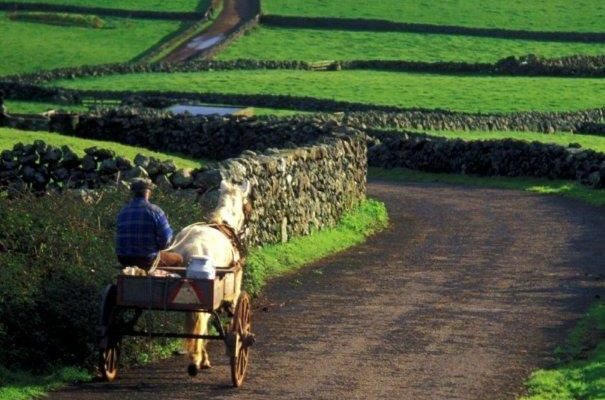

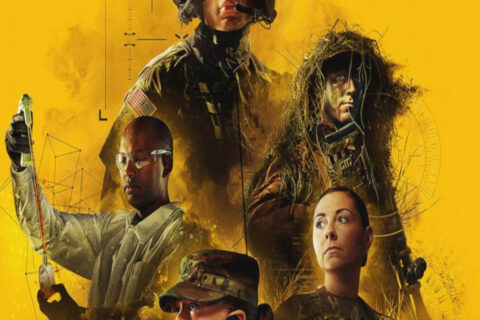
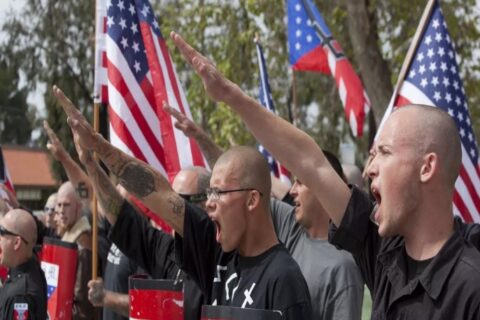
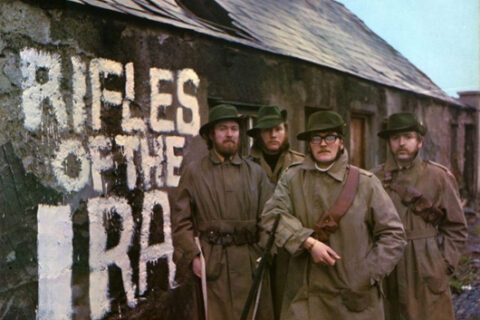

Irish national success, balderdash , under full Usury cartel “Refugee” invasion… ain’t a an Irish National government at all! Who are you kidding?
Hello, “erc.” Why don’t you tell us, in plain english, where precisely we’re going wrong. By “plain english,” I really just mean plain spokenness, as opposed to the, well, unplainspokenness of your post above. Clarify, my brother!
It was deleted already…
Is that clear and “plain English” and “plain spoken” enough for you Mr. Morris?
Nothing about universalizing Christianity is Kinist. If you claim your”nation” is Christianity, your no kinist but a bolshevik…
Well, kind of. We’re Christians and therefore pinko Commies and Bolsheviks to your muddled thinking. That much at least is clear.
Huh? Who is claiming that his/our nation is Christianity? Where are you reading this stuff? Or, strike that: what weird, confused goings on in your head have caused you to form that brilliant conclusion?
Well, anyway, not sure why you quoted from Mr. Devanny’s article. Why don’t you tell me in plain English what your point in doing so was/is. Tread lightly.
Mr. Morris, you obviously are enraptured (pun intended) delusion and cannot follow a logical assessment of your enslavement at all…
Erc, be that as it may, you’re not making a very good case for your position. I’ll ask again: please explain why you cited Mr. Devanny’s article. Is that excerpted passage suppose to prove something or other?
No one is obliged to take you seriously when you make logical leaps like you’re prone to do. Connect the dots for us, bro.
You clearly did not read the article. But I appreciate your visit to the site.
Erc has managed to make sure that no discussion has been had of the article or its contents.
_______________________________
To the author: I am grateful for your insight and willingness to cut through the noise around us and begin talking about real models for resistance. Its been a long time coming.
To your point, that its time to decide and act, there is what seems to me to be a critical intermediate step that needs to be made first. We are not organized in homogeneous or close knit groups that can operate with centralized strategic purpose, but tactical independence. We are spread out and fractured.
This would seem to be an obstacle we need to overcome.
Coming back to my original point about Erc the agent of distraction, we need to organize in a forum that is less easily disrupted, and comment sections on a blog aren’t it.
My assessment of our current circumstances are this. Its time to get back into meatspace and see eachother face to face where we can get the measure of one another and weed out the trolls and malefactors in our midst.
Its going to take time to build trust and cohesion. Years probably.
Lots of us dont have the luxury of close kin groups to draw on for family loyalty. There isn’t inherent ethnic homogeneity even in the deep south, let alone the extended south and midwest where most of the people with simlar sensibilities reside. Or religious homogeneity.
What then can we leverage to create a gravity that pulls small groups of folks together, that can overcome the pernicious incentives that exist in society for people to actively work to disrupt that cohesion?
This question needs answered, and the discussion will need to be had in a forum where people can be held physically accountable for their behavior.
We absolutely have to figure out how to get this ubiquitous presence of crazies and boneheads out of our midst. We can’t afford the waste of time that constantly combating this stupidity costs us.
Thank you for your thoughts and commentary, Ironic. Your main point – small, interpersonal organization is the only way to make this move forward. Nationalist entities should make meetings and action a priority.
The small groups you’re describing sound like local church congregations. That is, congregations who take theology and church discipline seriously.
Logical Facts are facts buddy …
I have lived and worked in Northern Ireland and would consider myself an Ulster Loyalist –to hell with the English and God Save the Queen– although I have dear friends who are strong Irish Nationalists. One of the tactics I observed in the mid-90s, well prior to the Good Friday Accord, used by Nationalists was what they called non-compliance. People in Nationalist neighbourhoods would not pay any money to any entity of the Government: they wouldn’t pay their gas or water bills, refused to buy a TV license, or refused to pay their rent if they lived in Council housing. If the utilities came to disconnect them, locals would threaten them or even set their vehicle on fire. They would let bureaucrats doing the Ulster government’s bidding know they knew who they were, where they lived, where their kids went to school, anything to intimidate them into not doing the government’s bidding. This seems to me to be a direct outgrowth of the tactics used against Crown officials during the Anglo-Irish War, and always reminded me of the scene in Goodfellas when they beat the shite out of the mailman delivering truancy notices to Henry Hill’s home: before long the mailman didn’t deliver any mail and their intimidation worked. It has always seemed to me like an effective tactic. If an overwhelming majority of people simply refused to pay the IRS they would cease to exist. Just my 2p’s worth.
@Luddite, to your second to last sentence. I worked in the 80s with a group of tradesmen who rightly determined the IRC stated they were not “employees” and did not earn “income” under the letter of the law. All 20 decided to stop paying their taxes and all 20 went to prison. Yes, it will take an overwhelming majority and the will to stay the course when the IRS seizes your bank account, forecloses on your home/business or starts sending the local SWAT team to drag your sorry, unpatriotic, scofflaw ass to jail (sarc). Don’t get me wrong, I am down with it and stick it to Leviathan EVERY chance I get. That said, I have my doubts we have the resolve in Dixie to take such a collective stand based on the Covid-19 house arrest compliance I have seen in my AO – just sayin’.